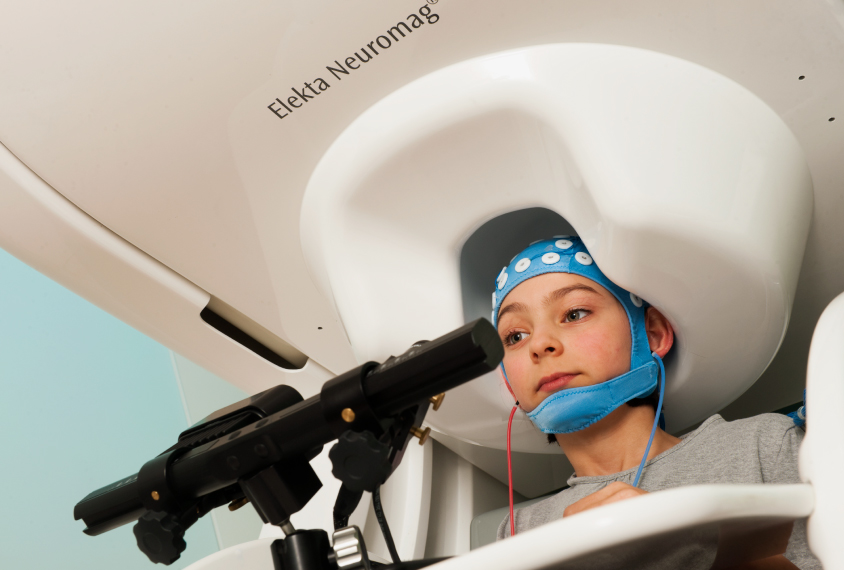
Autistic children may have to mute own perspective to grasp others’
To understand another person’s point of view, children with autism may need to actively suppress their own.
To understand another person’s point of view, children with autism need to actively suppress their own, a new study suggests1.
People with autism struggle with theory of mind — the ability to guess others’ thoughts and feelings. This may contribute to their social difficulties. The new work hints at the brain processes that underlie their difficulty.
The researchers used magnetoencephalography (MEG) to monitor brain activity in autistic and typical children, aged 8 to 12 years, as they performed a version of a classic theory-of-mind test. This test involves inferring someone else’s knowledge about the location of an object.
Typical children generally pass this test by the time they are 5. Most children with autism don’t pass until their teens, but those with high intelligence and strong language skills may figure it out sooner.
The autistic children in the new study perform the task as well as their typical peers do, but their brain activity differs: Unlike typical children, those with autism heavily recruit an area involved in inhibiting brain activity.
This finding suggests that they actively suppress their own belief about where the object is, says lead investigator Margot Taylor, director of functional neuroimaging at the Hospital for Sick Children in Toronto, Canada. This suppression may be an adaptive response. “They are smart kids, and they have to use some other strategies to perform these types of tasks,” she says.
Find the ball:
Theory-of-mind tasks involve several brain regions — each processing social cues and passing information on to the next. MEG can reveal which areas are active and when, with millisecond accuracy. The method has been used to identify sensory differences in people with autism, for instance, split-second delays in their processing of sound.
“This paper makes a really concrete attempt to capitalize on the spatial and temporal abilities of MEG but actually use it in a cognitive paradigm,” says MEG expert Timothy Roberts, professor of radiology at the Children’s Hospital of Philadelphia. Roberts was not involved in the new work.
The study included 19 autistic and 22 typical boys and girls. Both groups have average intelligence quotient scores in the normal range: 110 for those with autism and 120 for the typical children.
With their head inside an MEG scanner, the children looked at a set of pictures in which a character called Jill sees a character called Jack holding a ball over one of two hats and then dropping the ball into that hat. But Jack sometimes changes his mind and drops it into the other hat.
In one scenario, Jill witnesses Jack’s actions and knows where the ball is. In another, she is absent when Jack drops the ball; if he switches hats, she falsely believes that the ball is in the hat he had originally held it over.
The researchers monitored the children’s brain activity as they processed accurate and false beliefs and pointed to the hat Jill thinks the ball is in. “By comparing the two, we’re subtracting out all that is common to both tasks and can see what’s different only between when a child has a false belief versus a true belief,” Taylor says.
During false-belief processing, typical children show activity in the left temporal parietal junction, 300 to 500 milliseconds after seeing Jack switch his decision. This region is known to be a primary player in the theory-of-mind network. In that same period, children with autism show low activity in this region but high activity in the right inferior frontal gyrus, which works to suppress unwanted thoughts and responses.
“They really have to shut down their own understanding of where the ball is,” Taylor says.
The differences in brain activity are fleeting, however. “If you didn’t have high temporal resolution, you would have never picked that up,” Roberts says. The study appeared in September in Developmental Cognitive Neuroscience.
Alternative means:
The validity of the false-belief task as a test for theory of mind has come under scrutiny in the past decade, however. Older autistic children and those with milder traits often do well on the tasks in a lab but have problems tracking others’ perspectives in real life.
“It would be brilliant if we could see the timeline of brain activity using a task that older children with autism are still poor at,” notes Sander Begeer, assistant professor of developmental psychology at the VU University Amsterdam in the Netherlands, who was not involved in the work.
Still, there are advantages to using tasks that autistic children do well, Taylor says: Such tasks can illuminate the mechanisms autistic children use to overcome their difficulties. “We can see what different parts of their brain they are using to arrive at the same place,” she says.
This information may be able to guide attempts to improve autistic children’s social skills.
The team is studying various measures of theory of mind in adults, as well as in children born prematurely, who are at increased risk for autism. They also plan to look at children younger than 8 using a new, pared-down MEG scanner that fits over the scalp.
References:
- Yuk V. et al. Dev. Cogn. Neurosci. 34, 139-147 (2018) PubMed
Recommended reading

New organoid atlas unveils four neurodevelopmental signatures
Explore more from The Transmitter

The Transmitter’s most-read neuroscience book excerpts of 2025

Neuroscience’s leaders, legacies and rising stars of 2025


